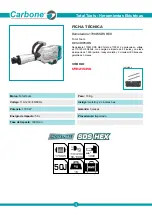
6
Electrical Connections
This jointer can be 1 Phase based on your
order and is wired for 220 volt.
Grounding Instrctions
1.
All grounded, cord connected tools:
In the event of a malfunction or breakdown,
grounding provides a path of least resistance for
electric current to reduce the risk of electric
shock. This tool is equipped with an electric cord
having an equipment- grounding conductor and a
grounding plug. The plug must be plugged into a
matching outlet that is properly installed and
grounded in accordance with all local codes and
ordinances. Do not modify the plug provided - if
it will not fit the outlet, have the proper outlet
installed by a qualified electrician.
Improper connection of the equipment-grounding
conductor can result in a risk of electric shock.
The conductor with insulation having an outer
surface that is green, with or without yellow
stripes, is the equipment-grounding conductor. If
repair or replacement of the electric cord or plug
is necessary, do not connect the equipment-
grounding conductor to a live terminal. Check
with a qualified electrician or service personnel if
the grounding instructions are not completely
understood, or if in doubt as to whether the tool
is properly grounded.
Use only 3-wire extension cords that have 3-
prong grounding plugs and 3-pole receptacles
that accept the tool’s plug.
Repair or replace damaged or worn cord
immediately.
Warning:
If the machine does not come wired to
run, the electrical and motor wiring must be done
by a qualified electrician. The machine must be
properly grounded to help avoid electrical shock
and possible death. Follow the recommendations
made by the National Electrical Code for grounding.
2.
Grounded, cord-connected tools intended for
use on a supply circuit having a nominal rating
between
150-250 volts, inclusive:
This tool is intended for use on a circuit that has
an outlet that looks like the one illustrated in
Sketch D Figure 7. The tool has a grounding
plug that looks like the plug illustrated in Sketch
D.
Make sure the tool is connected to an outlet
having the same configuration as the plug. No
adapter is available or should be used with this
tool. If the tool must be reconnected for use on a
different type of electric circuit, the reconnection
should be made by qualified service personnel
and after reconnection, the tool should comply
with all local codes and ordinances.
EXTENSION
CORDS
Use
proper
extension
cord.
Make
sure
your
exten-
sion
cord
is
in
good
condition.
When
using
an
exten-
sion
cord,
be
sure
to
use
one
heavy
enough
to
carry
the
current
your
product
will
draw.
An
undersized
cord
will
cause
a
drop
in
line
voltage
resulting
in
loss
of
power
and
overheating.
Figure
8
shows
the
correct
size
to
use
depending
on
cord
length
and
nameplate
ampere
rating.
If
in
doubt,
use
the
next
heavier
gauge.
The
smaller
the
gauge
number,
the
heavier
the
cord.
Ampere
Rating
Volts
Total
length
of
cord
in
feet
230
25'
50'
100'
150'
More
Not
Than
More
Than
AWG
0
6
6
10
10
12
12
16
18
16
16
14
18
16
14
12
16
16
14
12
14
12
Not recommended
Grounding Pin








































